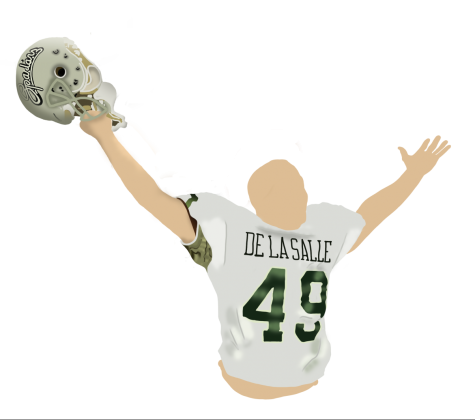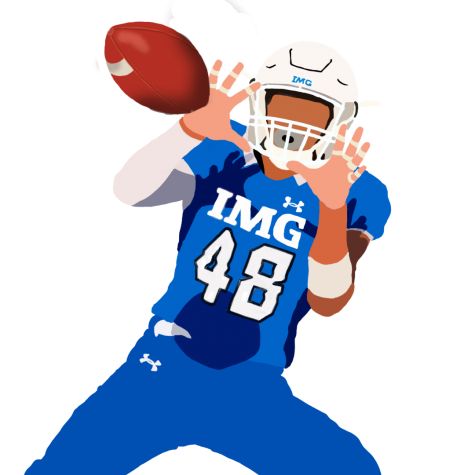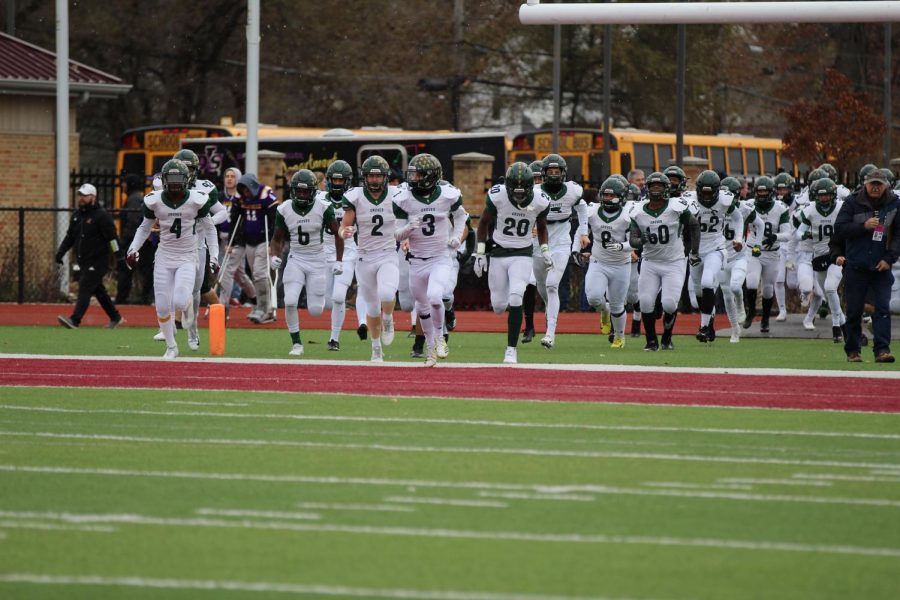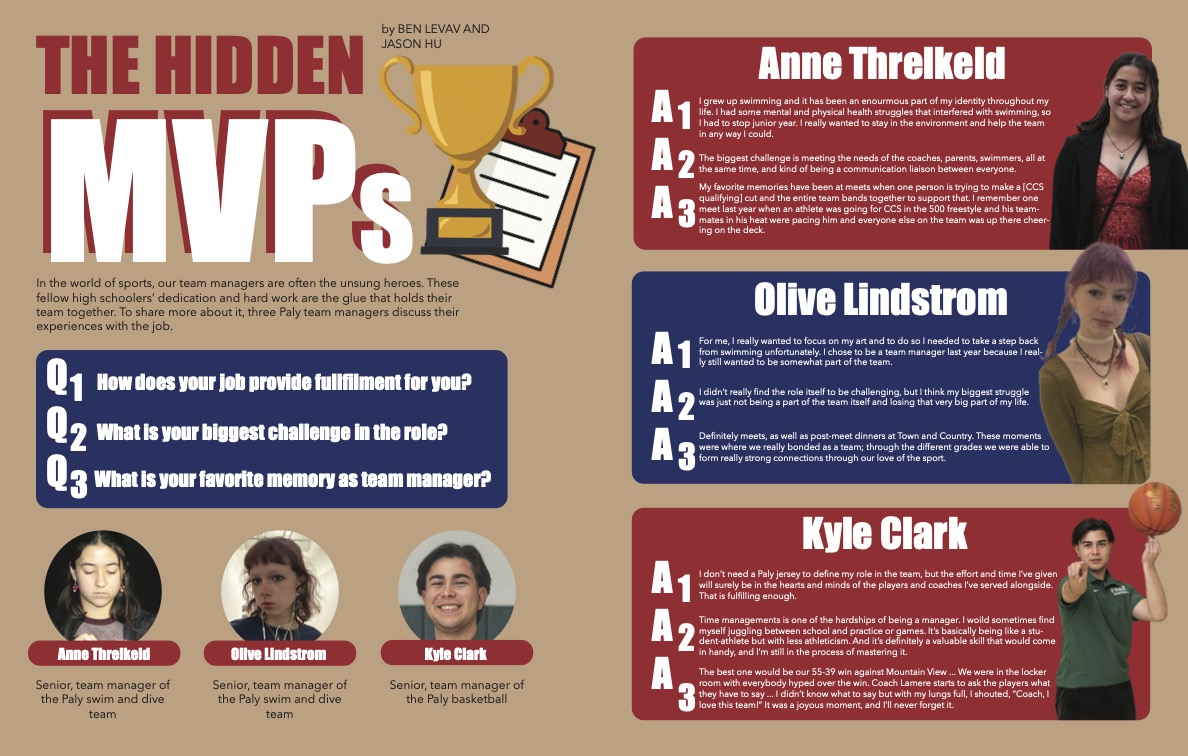High School Powerhouses
Athletics has long been a staple of the high school experience. Some schools are known for having dominant sports teams, and other teams are known for their mediocrity. But what drives this disparity? The answer lies at the heart of a fundamental but under-recognized truism in sports: winning teams perpetuate their success by being magnets for talented athletes.
De La Salle takes the field. Photo courtesy of Birmingham Groves High School.
November 12, 2019
On a September night in 2004 before the watchful eyes of 25,000 fans, a football game was underway between elite high schools De La Salle and Bellevue High. For the fair-weather fan, this game was like any other matchup. But for the hard-core fan, the game had the potential to rewrite history.
The outcome of this game would either end or extend the longest winning streak in football history: 151 straight wins for De La Salle High School. On De La Salle’s first drive of the game, a 45-yard touchdown run had fans hopeful for yet another win. But much to their dismay, Bellevue High dominated the rest of the game and went on to win, 39-20. This marked the end to a feat so prolonged it seemed like it would last forever.
The magnitude of De La Salle’s achievement had people wondering: How had they managed to dominate the game for so long? The reason is because De La Salle’s winning tradition attracts more gifted young athletes seeking to be part of a reputable program, thus perpetuating their success.
This pattern is circular: A successful high school athletics program continues to dominate because of their previous achievements. Conversely, a school sports team that has a reputation of being bad will perpetuate inferiority by failing to attract top athletes. Few good athletes would want to waste their prime being stuck on a losing team.
Current Paly track and cross country coach Michael Davidson reasons that the image of a team is a significant determinant for success.
“Reputation has the ability to have a tremendous influence on the future because it sets the precedent; it sets the culture, whether it is positive or negative,” Davidson said.
While interviewing Davidson, he was finishing up packing equipment after coming back from a cross-country at Crystal Springs. At the meet, Paly cross- country athletes dominated the field. They placed in the top three for all six races, including four races where Paly won outright. When talking about the culture of a team, Davidson’s eyes light up at the prospect of being in charge of a program with a fearsome reputation. This is his goal as a coach: He knows that building a successful team culture inspires future athletes to step up and continue the legacy of the program.
In other words, Davidson figures that an athlete considering where to play in high school will say: “Oh, man, that program’s garbage man. Those guys, they go horse around. Or, hey, man, if you go for that team, they work hard and practice every day, right? They’re going to have sessions six days a week, you’ve got to be really serious and focused.”
Davidson wants to make sure that the rumors surrounding the Paly team resemble the latter commentary and not the former. His grueling 7 a.m. Saturday practices and the successes of his team reflect this goal.
These differences in a team’s reputation significantly affect the decisions that many athletes make when deciding where to attend high school. Take swimming sensation Jackson Picard, a freshman at Sacred Heart Preparatory, who recently had to grapple with a multitude of different options when deciding where to apply for high school. Picard is coming off a particularly outstanding summer of swimming. At Speedo Sectionals in Santa Clarita he qualified for USA Swimming Futures Championships in the 200-meter butterfly. After careful deliberation, Picard chose to attend Sacred Heart Prep, which has developed a reputation for being one of the top schools in the nation for water polo. This success in water polo has translated to swimming—the boys swim team finished second behind Bellarmine in the Boys 2019 Central Coast Section swimming championships. This, along with dominance in the West Bay Athletic League, has cemented the boys swim team as serious contenders.
Reputation has the ability to have a tremendous influence on the future because it sets the precedent; it sets the culture, whether it is positive or negative
— Michael Davidson
This reputation is what drove Picard to choose Sacred Heart. He wanted to join a program where his talent would be on display.
“I wanted a school that had a lot of potential to be dominant in swimming for the next few seasons,” Picard said.
Picard’s experience illustrates how success perpetuates success. Sacred Heart’s notable achievements in swimming helped convince Picard to join, and his bright future will likely lead the team to many triumphs in the years to come.
Sacred Heart’s ability to dominate in several sports is in part due to the increased funding available to private schools, allowing them to improve other aspects of a program that lead to success. This includes the coaching staff, the facilities, the equipment, and so on. The ability to fund their athletic programs more extensively allows private schools the upper hand compared to public institutions.
Further emphasizing this divide, private schools have access to resources that allow them to recruit better players into their programs, which helps them keep a consistent influx of talent. This gives them an advantage over public schools, which are regulated more tightly and have no power to actively recruit young athletes. Simply put, a team is only as good as the sum of its parts; these components tend to heavily depend on the aforementioned factors.
Some high schools take athletic recruitment to a whole new level. Schools such as Montverde Academy in Montverde, Florida, and IMG Academy in Bradenton, Florida have revolutionized the high school recruitment process through the implementation of their unique strategy: recruiting while players are in high school.
While most schools attempt to attract players straight out of middle school and develop them for four years, IMG has found it beneficial to encourage players to transfer to their school during their junior or senior years of high school. In utilizing this strategy, their team is usually comprised of players who have already proven themselves in high school, creating a football super-team. Montverde boasts notable alumni D’Angelo Russell, Ben Simmons and RJ Barrett, while IMG alumni include Dylan Moses, Shea Patterson and Deandre Francois.
What attracts players to IMG, and why don’t other schools employ a similar strategy? Top athletes are drawn to IMG in part because they have some of the best facilities in the nation, comparable to those of most Division I colleges. They boast a 5,000 seat stadium, state of the art locker rooms, multiple practice fields and a virtual reality training center. The best athletes are offered scholarships to attend the school, however those without are required to pay the lofty tuition of $72,500.
The school’s recruiting model is incomparable because of its initial capital investment. IMG is an acronym for International Management Group, which is a talent management company based in New York City. They have been growing the high school and its sports programs since 1987. Public schools don’t have the luxury of being backed by a corporation, and thus their facilities are typically lackluster. At the end of the day, money makes an impact.
The difference in funding results in a difference in talent and the split only becomes more drastic as time progresses. However, this type of school solely focused on producing recruits and not wins is rarer; most high schools yearn to be successful in the moment, not 10 years down the road.
A local high school that has been known for recruiting middle-school-aged players to ensure the success of their high school teams is Saint Francis High School, a private school in Mountain View. This approach has proven to be successful: the Saint Francis baseball team has consistently been one of the best in California and even reached a top ten national ranking in 2015.
The coaches won’t tell you they were recruiting people to go there because that’s against the rules, but they were
— Ryan Degregorio
Despite efforts from many administrations to curb the practice of scouting young athletes, coaches tend to find loopholes to such rules, typically holding informal meetings to keep an eye on local talent.
Ryan Degregorio, a former baseball player for St. Francis and the current varsity pitching coach for Paly, has had first-hand experience with this process.
“The [Saint Francis] baseball team organization every winter ran a one to two-week baseball camp for seventh and eighth graders,” Degregorio said. “That was part of their recruitment process in order to figure out which [athletes] were the best, which ones were good, and [those] that were not meant to play baseball. The coaches won’t tell you they were recruiting people to go there because that’s against the rules, but they were.”
When so many factors come together to produce excellent teams, the players on the field know the implications of their success.
“We’re better than you, we know we are, and were going to prove it,” Degregorio said of the attitudes of players on winning teams. “Just having that swagger, that feeling that you’re better than everyone is a feeling that just about every player on that team has.”
The “swagger” that private schools boast helps create a reputation that recruits players, like Jackson Picard, to their schools. This creates a circular pattern that helps schools, like De La Salle, maintain superiority. This gap in talent is so wide that a single team can go on winning for 12 years straight.
We’re better than you, we know we are, and were going to prove it.
— Ryan Degredorio
You might be thinking to yourself, “How is it fair for public schools and private schools to compete against one another when the odds are so heavily stacked in the private school’s favor?” And you’re right: it’s not. But this is where the magical essence of high school sports is found — that moment when an underdog breaks a 12 year winning streak in single game—and is a favorite theme of many sports books and movies.
This includes McFarland USA, a film about a central valley high school cross- country team that beats the odds and wins against more prestigious schools. Interestingly enough, the stereotypical prestigious school featured in the movie happens to be our very own Palo Alto High School. However, given that Paly is nearly 250 miles away from McFarland and is not even in the same section, the interactions between the two schools are entirely fictional.
Despite being characterized as the powerhouse in McFarland USA, Paly competes locally with schools like Bellarmine, Sacred Heart, and Saint Francis. These private schools tend to dominate Paly in certain sports. Take Bellarmine, which won the boys Central Coast Section swimming championships 31 years in a row.
Thirty-one consecutive years! That’s the longest championship streak of any sport in CCS history.
Bellarmine was taken down by none other than (you guessed it!) Palo Alto High School. Just kidding. It was actually Gunn, which in 2016 brought an end to a streak that seemed infallible. The best part about the win was that it all came down to the final race: the 400-meter Freestyle Relay, an event that the Bells traditionally excel at. But thanks to an outstanding effort by both Palo Alto high schools (Gunn finished 1st in the race, followed by Paly in 2nd and Bellarmine in 3rd), Gunn was crowned champion and the streak was over.
The following year, in 2017, Bellarmine went right back to winning. The 2018 and 2019 section titles were also both claimed by Bellarmine. But as the 2020 swim season approaches, maybe this three-year streak will be brought to an end by Jackson Picard and Sacred Heart Prep. Or maybe even by Paly, which has high hopes with seniors Dexter Gormley and Jack Hogan returning for their last year.
Reputation and money drive the repeated success of many winning sports teams. But the enduring appeal of sports will always be that on game day anyone can win. There’s nothing quite as sweet as the triumph of the underdog. Sko Vikes!








